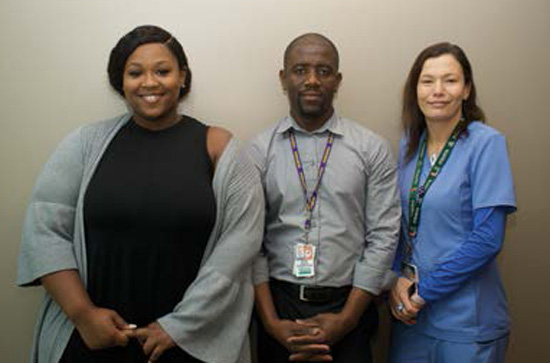Florida Partnership Yields Results
October 29, 2018
Contract success at University of Miami Hospital is a lesson in solidarity.

“It was a really good experience,” says Service Response Representative Chiquita Brunson. “This was not my first time sitting at a bargaining table. I can say this was a little more intense. We were talking about money, but it was also definitely more of a partnership with management. It was a hard conversation to have, but we were able to work things out.”
Since re-launching the labor-management partnership at UMH in 2012, 1199ers have approached negotiations and problem solving with a robust sense of collaboration. The hospital was among the first in Florida to establish a $10.10 per hour minimum wage (now at $11.00). Cooperative efforts have yielded marked success in overall patient satisfaction, including reduced patient wait times and improvements in wound care.
“We were talking about money, but it was also definitely more of a partnership with management. It was a hard conversation to have, but we were able to work things out.”
The new wage agreement was ratified in July and covers 2,150 UMH workers. The wage provision includes a 2%, across-the-board raise for employees who are fairly compensated in their title, given experience and market conditions, and increases of up to 23% for those who are in critical and difficult- to-fill positions or who earn less than or close to employees with less experience, licensure or years of service. Some RNs received higher increases to harmonize RN pay system-wide. Employees whose current rate is higher than the maximum for their classification received a lump sum bonus. (Per diems receiving fair and flat rates and those who already received a second pay raise did not receive an increase.)
Brunson notes that raises did not necessarily meet everyone’s expectations.
“But I explained to them that we have got to start somewhere; this is just the beginning of the road and we need to have somewhere to go [with increases],” she says. “I think people understood and they really stepped up.”
To fairly distribute resources earmarked for raises, workers and union staff gathered and analyzed a trove of data related to local healthcare trends in staffing, training, standards, salaries, wage compression and other factors.
“We knew we had to get wage comparisons and we got them,” says Ekco Tech Sarah Campbell. “The main part was the anxiety around management’s response.”
“The committee’s work effectively demonstrated the deleterious effect wage compression has on retention,” says RN Henry Pouerie.
“We had a lot of nurses go work at other institutions and it was a real drain on the organization. The hospital was losing employees and having a tough time filling positions. South Florida is very competitive,” says Pouerie, a negotiating committee member.
1199SEIU VP Dequasia Canales emphasized the critical role of worker solidarity: “We had people who were willing to take a little less so others could get higher raises.”
Negotiating Committee Member Elizabeth Jazon, a UMH RN for 10 years, received a lump sum but was unfazed, citing the priority of the collective in trade unionism.
“We are one team. We have one voice. As a delegate and executive council member I knew I wasn’t there just to fight for me,” says Jazon. “I knew I needed to be there for my co-workers. I kept it positive. I saw people there whose eyes were opened when they saw what could be achieved by us working together.”
1199 Magazine | September - October 2018

